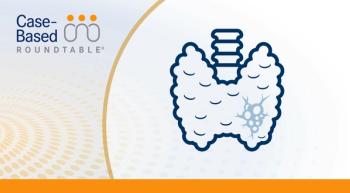
TKI Therapy: Impact of Age and Adverse Events
Lori Wirth, MD: In this case, our patient is 64 years old. What role does age play in the decision to treat patients with MKIs [multikinase inhibitors] who have iodine-refractory DTC [differentiated thyroid cancer]?
Marcia Brose did an analysis of patients from the SELECT trial based on their age. The age cutoff was 65 years of age. In patients older than age 65, which is the older patient population, did they benefit from lenvatinib compared with younger patients? What was perhaps somewhat surprising was that there is a benefit in terms of response rate. Patients who are older also have progression-free survival benefits. What was also surprising was that the patients who were older than 55 years of age had an overall survival benefit when they were initially randomized to lenvatinib compared with placebo.
It’s important to remember that this was a crossover trial. The patient initially enrolled on placebo crossed over to active therapy when they had disease progression. Nearly all patients received lenvatinib on the treatment. The question is whether to use lenvatinib earlier versus later. We saw on overall survival benefit with the older patients who were initially treated with lenvatinib compared with those who were initially treated with placebo. We know from these data that we don’t want to withhold lenvatinib based solely on age. Even patients who are older will perhaps have an overall survival benefit.
Is this practice changing? For me it was because of the adverse-effect profile with lenvatinib. The older-patient population may not fare as well in terms of the adverse effects, so it is a more challenging decision to consider the risk-benefit ratio in the older-patient population that may have more difficulty with adverse effects.
When there’s an overall survival benefit, it’s important to think about use of therapy in the appropriate patients who are going to be able to tolerate the therapy with appropriate management of their adverse effects.
Patients often ask me, “What is it going to be like on lenvatinib?” and “How long am I going to be on it?”
In terms of the most common adverse effects we see, hypertension is 1 of them. We see hypertension frequently in these patients. The onset can be very early, even after just a couple of days. It is important to manage hypertension carefully. We also know that patients who develop treatment-emergent hypertension have an overall survival benefit compared with those who don’t. When patients develop hypertension, you don’t want to stop lenvatinib, but you want to manage the hypertension because it’s a pharmacodynamic marker of benefit from the therapy.
Patients will also often have fatigue. They have some diarrhea, anorexia, and occasionally nausea. All these adverse effects need to be managed very actively in order to be able to keep patients on therapy. We take advantage of our dietitian, and we take advantage of other supportive medications to keep people feeling as well as possible. Occasionally, dose holds and dose reductions are definitely necessary in managing patients on lenvatinib.
One thing we’ve learned from looking at the data is that you don’t want to hold the therapy for too long, because patients who had dose holds of longer than 10% of the time they were on the therapy didn’t do as well in terms of progression-free survival and response rate. The half-life of lenvatinib is short; patients often feel better very quickly. We try to keep our dose hold down to just a couple of days. After patients recover from the adverse effects that sponsored the dose hold, they often need to have a dose reduction. However, patients can sometimes resume the prior dose that they were on as well.
Another question that patients often ask is, “Do I have opportunities for other therapies?” We know from real-world data that, when patients have been on other MKIs such as sorafenib for iodine-refractory DTC and then progress, we see activity with second-line lenvatinib. Patients in Korea who were studied who received second-line lenvatinib had an overall response rate of 20%, so it was not quite as good as the first-line overall response rate, but it was still better than nothing.
Patients who went on to receive second-line lenvatinib had an overall survival benefit compared with patients who did not receive the second-line lenvatinib. Those patients may not have received second-line lenvatinib because they were too sick to receive second-line therapy, so we can’t say that we know there’s an overall survival benefit with lenvatinib compared with placebo in the second-line setting. However, we know that those patients in the real-world setting survived longer with second-line lenvatinib.
Transcript edited for clarity.
Case Information: A 64-Year-Old Man With Differentiated Thyroid Cancer
Initial Presentation
- A 64-year-old man presents with a solitary nodule on the neck and occasional shortness of breath and intermittent excessive fatigue
- PMH: unremarkable
- PE: palpable, hard and fixed solitary nodule
Clinical Workup and Initial Treatment
- Labs: TSH 10.3 µU/mL; all others WNL
- Ultrasound of the neck revealed a 2.2 cm mass near the isthmus of the thyroid; several suspicious lymph nodes ranging from 0.3-2.2 cm in size
- Ultrasound-guided FNAB: confirmed papillary thyroid carcinoma; with nuclear enlargement and nuclear grooves, no colloid seen
- Patient underwent total thyroidectomy with bilateral central neck dissection
- Pathology: 2.1 cm papillary thyroid cancer arising in isthmus of the thyroid, 3 of 7 positive central compartment lymph nodes, largest 1.8 cm, positive extra nodal extension
- StageT2N1MX; ECOG PS 1
Subsequent Treatment and Follow-up
- He was treated with radioactive iodine 150 millicuries
- Whole body scan showed uptake in the neck; indicative of thyroid remnant
- Follow-up at 3 months TSH 0.2 µU/mL, thyroglobulin 68 ng/mL
- Neck US showed no evidence of residual disease in thyroid bed, no suspicious neck nodes. Chest CT was done: > 15 lung lesions, largest 1.4 cm in size
- Lenvatinib 24 mg PO qDay was initiated











































